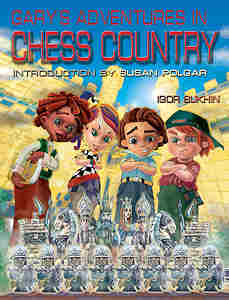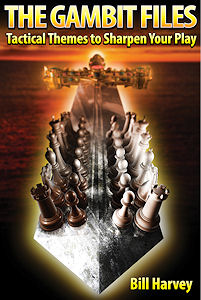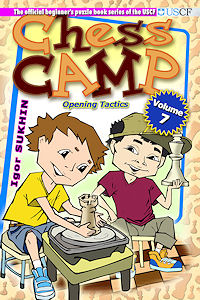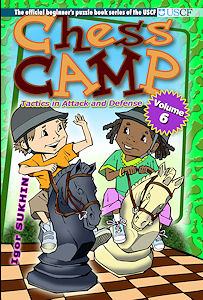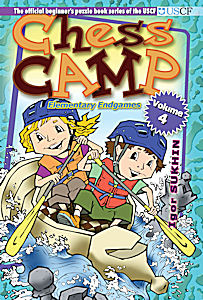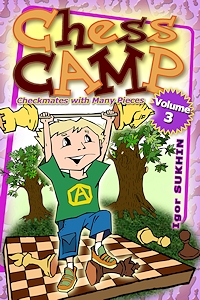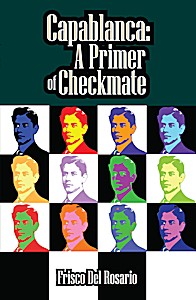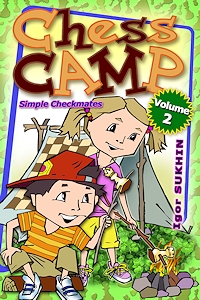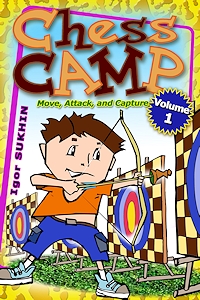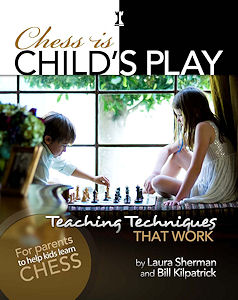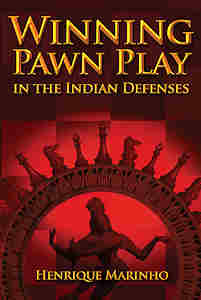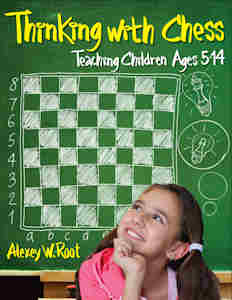Gary's Adventures in Chess Country
For centuries, chess has been the world's most popular board game. But did you know that it can also improve your child's ability to learn?Studies have shown that by focusing on basic chess concepts, children as young as four can improve their reasoning and develop their problem-solving abilities.Gary's Adventures in Chess Country is designed to help children delve into the world of chess through an engaging adventure story. Spirited away by a mysterious young girl on a magic tricycle, Gary is taken
- Sklep: Imperium Zabawek - Twój sklep z zabawkami Warszawa - Hurtownia
- Cena: 124.20 zł
The Gambit Files: Tactical Themes to Sharpen Your Play
Sharpen your sword! Puzzle king Bill Harvey presents 237 violent positions from 15 gambit variations – ranging from the rare Lisitsin and the neglected Blumenfeld, to the popular Milner-Barry and the fashionable Gajewski – where one side is poised to deliver the final blow.Studying typical tactics is one of the best ways to get to know an opening: you will discover the traps and the pitfalls, develop both a sense of danger and a feel for opportunities, and learn to stay always on the alert. In The
- Sklep: Imperium Zabawek - Twój sklep z zabawkami Warszawa - Hurtownia
- Cena: 85.56 zł
Chess Camp Volume 7, Opening Tactics
Chess Camp is a new training system for beginning chessplayers, and for the parents and coaches who teach them. Starting with simple problems to illustrate key concepts, and then progressing to more complex positions, the student will learn by doing, methodically integrating new information with previous knowledge while building effective thinking habits at the board.The seventh volume in this series, Opening Tactics, sets problems in more lifelike conditions, as they arise from standard openings a
- Sklep: Imperium Zabawek - Twój sklep z zabawkami Warszawa - Hurtownia
- Cena: 66.24 zł
Chess Camp Volume 6, Tactics in Attack and Defense
Chess Camp is a new training system for beginning chessplayers, and for the parents and coaches who teach them. Starting with simple problems to illustrate key concepts, and then progressing to more complex positions, the student will learn by doing, methodically integrating new information with previous knowledge while building effective thinking habits at the board.Volume 6, Tactics in Attack and Defense, presents 618 problems and exercises introducing the advancing student to more complex tactic
- Sklep: Imperium Zabawek - Twój sklep z zabawkami Warszawa - Hurtownia
- Cena: 66.24 zł
Chess Camp Volume 5, Two Move Checkmates
Chess Camp is a new training system for beginning chessplayers, and for the parents and coaches who teach them. Starting with simple problems to illustrate key concepts, and then progressing to more complex positions, the student will learn by doing, methodically integrating new information with previous knowledge while building effective thinking habits at the board. In Two-Move Checkmates, the fifth volume in the Chess Camp series, the student will be introduced to the elements of planning, aiming
- Sklep: Imperium Zabawek - Twój sklep z zabawkami Warszawa - Hurtownia
- Cena: 66.24 zł
Chess Camp Volume 4, Elementary Endgames
Chess Camp is a new training system for beginning chessplayers, and for the parents and coaches who teach them. Starting with simple problems to illustrate key concepts, and then progressing to more complex positions, the student will learn by doing, methodically integrating new information with previous knowledge while building effective thinking habits at the board.In this fourth volume, Elementary Endgames, the student will: 1) learn how to deliver fundamental checkmates such as a king and a roo
- Sklep: Imperium Zabawek - Twój sklep z zabawkami Warszawa - Hurtownia
- Cena: 66.24 zł
Chess Camp: Volume 3
Chess Camp is a new training system for beginning chessplayers, and for the parents and coaches who teach them. Starting with simple problems to illustrate key concepts, and then progressing to more complex positions, the student will learn by doing, methodically integrating new information with previous knowledge while building effective thinking habits at the board.In Checkmates with Many Pieces, the third volume in the series, the student will: 1) find his or her way to mate in more complex posi
- Sklep: Imperium Zabawek - Twój sklep z zabawkami Warszawa - Hurtownia
- Cena: 66.24 zł
Capablanca: A Primer of Checkmate
José Raúl Capablanca is renowned for his exquisite positional play and flawless endgame technique. But #8220;The Chess Machine#8221; was also a master of that other way to deliver mate: the attack on the enemy king.In this groundbreaking work, award-winning chess coach and author Frisco Del Rosario shines a long-overdue light on this neglected aspect of Capablanca#8217;s record. He illustrates how the Cuban genius used positional concepts to build up irresistible king hunts, embodying the principles
- Sklep: Imperium Zabawek - Twój sklep z zabawkami Warszawa - Hurtownia
- Cena: 104.88 zł
Chess Camp: Volume 2
Chess Camp is a new training system for beginning chessplayers, and for the parents and coaches who teach them. Starting with simple problems to illustrate key concepts, and then progressing to more complex positions, the student will learn by doing, methodically integrating new information with previous knowledge while building effective thinking habits at the board.The second volume in this series, Simple Checkmates, contains 618 structured problems, exercises, and fun puzzles that will help the
- Sklep: Imperium Zabawek - Twój sklep z zabawkami Warszawa - Hurtownia
- Cena: 66.24 zł
Chess Camp: Volume 1
Chess Camp is a new training system for beginning chessplayers, and for the parents and coaches who teach them. Starting with simple problems to illustrate key concepts, and then progressing to more complex positions, the student will learn by doing, methodically integrating new information with previous knowledge while building effective thinking habits at the board.In this first volume, Move, Attack, and Capture, the student will discover how the chess pieces move; start to get a feel for the che
- Sklep: Imperium Zabawek - Twój sklep z zabawkami Warszawa - Hurtownia
- Cena: 66.24 zł
Chess Blueprints: Planning in the Middlegame
Planning is critical to winning in chess. While other writers offer you thinking tools for building an effective plan, in Chess Blueprints: Planning in the Middlegame Nikolay Yakovlev gives you the bricks – the positional themes and patterns that you need to know in order to make use of those fancy tools. With 188 positions and 559 diagrams ranging from the classics to little-known gems of Russian chess, the author challenges you to form your own impression and then see how the masters honed in on
- Sklep: Imperium Zabawek - Twój sklep z zabawkami Warszawa - Hurtownia
- Cena: 131.10 zł
Chess is Child#8217;s Play: Teaching Techniques That Work
Chess is Child's Play is a book written by parents, for parents. It is written for YOU!Chess is one of the oldest strategy games known to man. Studies show that children who learn chess at an early age gain such valuable life skills as: Problem-solving ability Enhanced imaginationImproved patience and focusGreater self-confidence.Chess educators Laura Sherman and Bill Kilpatrick have created an easy, step-by-step method for teaching chess that parents of all skill levels can use to teach children of any
- Sklep: Imperium Zabawek - Twój sklep z zabawkami Warszawa - Hurtownia
- Cena: 104.88 zł
Amateur to IM: Proven Ideas and Training Methods
International Master Jonathan Hawkins was a relatively slow starter in the world of chess.Learning the game at the age of eight, he was a keen junior who won a number of local tournaments. But by his own admission, #8216;by the time I was in my mid-teens my age-to-playing-strength ratio was distinctly average.#8217;He started to study chess very seriously in his late teens and achieved a rapid rise through the ranks. He became a FIDE Master in 2008 and earned the title of International Master in 2010. 20
- Sklep: Imperium Zabawek - Twój sklep z zabawkami Warszawa - Hurtownia
- Cena: 150.42 zł
Winning Pawn Play in the Indian Defense
The King#8217;s Indian and Benoni defenses may look similar, but they lead to vastly different strategies for each player. Why does White usually attack on the queenside in the King#8217;s Indian but on the kingside in the Benoni, while Black does the opposite? Do you know when and where to launch your pawns forward, and when to rely on piece play? Can you stop your opponent from blocking up the position? Are you mystified by the subtle differences that totally change the game?In Winning Pawn Play in the
- Sklep: Imperium Zabawek - Twój sklep z zabawkami Warszawa - Hurtownia
- Cena: 131.10 zł
Thinking With Chess: Teaching Children Ages 5-14
What#8217;s the best way to teach chess to children? Thinking with Chess: Teaching Children Ages 5-14 is a handbook for teachers, librarians, after-school instructors, chess coaches, counselors, and parents that requires no prior knowledge of the game. Both novices and veteran chess players can use its innovative lesson plans for teaching groups of children.InThinking with Chess, Dr. Alexey Root connects chess with skills important to academic success, such as classifying, pattern recognition, decoding,
- Sklep: Imperium Zabawek - Twój sklep z zabawkami Warszawa - Hurtownia
- Cena: 85.56 zł
